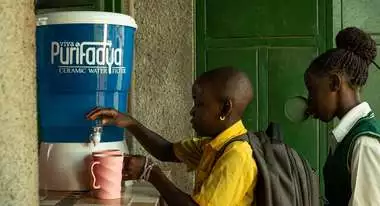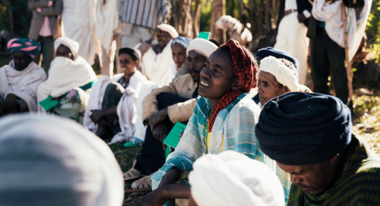Remittances Improve Nutrition and Agriculture in Rural Households
Remittances by Migrants can contribute to improving food security and reducing poverty in developing countries.

World-wide, people migrate across national borders in search of higher incomes and better lives. In addition, many people migrate within their own countries, for example, from rural to urban areas. Typically, migrants send some of their income to family members and friends in their regions of origin (“migrant remittances”). In this article, we discuss how migrant remittances help to improve food security and reduce poverty in developing countries.
Diverse migrant experiences and data sources
Patterns of migration and remittances-sending vary widely: Migrants may move temporarily or permanently; voluntarily or in response to persecution or conflict; with or without their immediate family; they may travel, reside and work in the destination country regularly or irregularly. Remittances may be sent monthly or for important life-cycle events (weddings, funerals) or mainly in emergencies (catastrophic illness, natural disaster). Remittances may be sent through formal channels such as banks or money transfer operators or through informal channels such as Hawala networks or they may be carried as cash foreign exchange by international travelers, transport operators or migrants themselves. For most migrants, sending remittances is part and parcel of the migration experience.
Because of the wide variety of migration experiences, available data on migration and remittances is incomplete. This is especially true for internal migration within a given country. In this article, therefore, we focus on international migrants. An international migrant is most often defined as an individual who is born outside their current country of residence. Therefore, census data and household surveys in the destination country contain pertinent information about each country’s immigrants, including their country of birth and certain socioeconomic characteristics.
However, we normally know little from these data sources about the interactions (such as remittances-sending) between international migrants and individuals in the countries of origin – or about the socioeconomic characteristics of these individuals (including whether they live in a rural area). Balance of payments statistics in countries of destination and origin only contain highly aggregated information on bilateral remittance flows. Academic research often uses targeted surveys in selected countries to investigate particular migration topics, but such data are typically not available over time or across many countries.
Impact channels
The most obvious and direct impact of family remittances is on those households that receive them. The International Fund for Rural Development (IFAD) (2017) summarizes a large body of research by stating (somewhat boldly) that 75% of family remittances typically pay for immediate needs – especially, eating better. In rural communities, half of remittances are reportedly spent on agriculture-related items. The remaining 25% of remittances are spent on various types of investment: health care for family members and schooling for children (i.e. investment in human capital, in economists’ jargon); and investment in physical capital like home improvements and funds for family enterprises.
In short, a key effect of remittances is that recipients, who are often poor, can afford to eat better. Irrespective of whether rural or urban households receive remittances, their additional disposable income strengthens demand for food and stabilizes food consumption. In turn, food producers (including small scale farmers) benefit from higher prices and reduced volatility, strengthening incentives for investment in the sector.

The indirect positive effect of remittances on food producers (and everyone employed in food production) illustrates the broader benefits of remittances beyond those who receive them. The more remittances a country receives, the more they will sustain demand for local goods and services and, ultimately, labor (in addition to paying for additional imports, which typically increase as well). The United Nations Conference on Trade and Development (UNCTAD) (2011) documents that remittances reduce poverty in developing countries especially when they account for more than 5% of GDP, which is a threshold surpassed in a large number of countries. Less poverty means more secure livelihoods and more food security.
While rural households benefit substantially from indirect effects of remittances through higher demand for food, they are also affected directly. Many international migrants originate from rural areas: In 10 out of 14 developing countries for which the Food and Agriculture Organization (FAO) (2018, Figure 7) has data, the share of rural migrants in the migrant population was similar to the share of rural residents in the total population. Reportedly, 40% of remittances to developing countries flow to rural areas, increasing disposable incomes there.
For many rural households, having a migrant abroad is a form of insurance against the volatility of agricultural earnings, natural disasters, and emerging climate risks. Even if migrants do not send remittances frequently, they typically step in when disaster strikes.
Migration is expensive
International migration is often costly to migrants – even when it does not involve irregular travel to a high-income country with the help of intermediaries. Typically, therefore, migrants tend to be relatively richer and better-educated than the non-migrant population. This is why in very poor countries (Bangladesh, Nepal), rural people account for a lower share of international migrants than of the general population. In less poor countries, rural individuals may choose less expensive, but also less financially rewarding migration corridors – for example, other developing countries rather than developed counties.
For rural migrants, internal and international migration are often connected. At first, a member of a rural household may move to an urban area within his or her country of origin. Only later – with more financial resources and better access to networks – may international migration become a viable option. However, many rural-to-urban migrants never move on to another country. World-wide, there are reportedly up to three times as many internal migrants (763 million as of 2013: UN Department of Economic and Social Affairs – DESA, 2013) as there are international migrants (280 million as of 2020).

Inevitably, given the heterogeneity of migrant experiences, migration not only has benefits but also entails risks to migrants as well as the households and communities whom they leave behind (Amuedo-Dorantes and Pozo, 2023). In particular, concern has been voiced that agricultural output could suffer when predominantly young migrants depart from rural areas. However, De Brauw (2019) concludes from a review of recent, methodologically sound publications that there is no evidence of a negative output effect as agricultural producers are normally able to adjust along one of several possible dimensions. Rather, remittances to rural areas have been shown to finance significant investment in agriculture.
Recent trends in remittances
The Covid19 pandemic disrupted lives and livelihoods all over the world. Global GDP fell by more than 3% in 2020 and many migrants either faced unemployment (when they worked in, say, the hospitality industry) or worked long hours as “essential workers” with little chance to protect themselves against the risk of serious illness (say, in health care).
It is remarkable how resilient migrant remittances have remained throughout this crisis (Figure 1). Global remittance flows to low- and middle-income regions dipped in 2020 but recovered forcefully in 2021 and have since continued to grow. This recent experience reinforces our earlier conclusions about the positive role that migration and remittances can play in reducing poverty and sustaining livelihoods, even in the face of a global economic downturn.
Figure 1:
Remittance flows to low- and middle-income regions, 2016-2024- estimates and projections
Policy implications
Migration and remittances are affected by a wide range of policies in countries of destination and origin. With a focus on rural livelihoods, the following policy areas deserve particular attention:
- Being able to send remittances to family and friends is an important motive for migration. Remittances are crucial for spreading the benefits of migration beyond migrants to recipient households and many others in countries of origin. One way to facilitate the sending of remittances is to reduce the cost of international money transfers which still varies widely across migration corridors and depending on the sender’s and recipient’s access to financial services. A recent survey puts the global average cost of sending US$200 to South Asia at just over 4%, whereas the same payment to Sub-Saharan Africa cost just under 8% (Ratha et al., 2023, Figure 1.7). With the support of international organizations, governments in countries of destination and origin are working to increase competition and transparency in the market for payment services. These ongoing efforts may be linked with (also ongoing) campaigns to increase financial literacy and access to financial services on the part of both senders and recipients of remittances. In this sense, remittances can be a starting point for financial development, especially in rural areas.
- Migrants from a given region often end up in geographic proximity within their destination countries. There are many examples of how Diaspora organizations have supported community projects in their home regions, funding public investment in social or physical infrastructure that would otherwise not have happened. Countries of destination and origin can usefully support Diaspora organization and their charitable activities (for example, by excepting cross-border donations from income tax).
- Finally, more legal migration opportunities would expand the range of options available to potential migrants in developing countries and increase potential remittances, including to rural areas. Circular migration – typically, seasonal work in agriculture in a high-income country – is politically less controversial than other types of migration (much produce would never be harvested if it were not for migrant labor). High-income countries, including in the EU, may consider expanding circular migration as part of their growing cooperation with developing countries in migration management. The protection of migrants’ rights, including to decent wages and working conditions, and the supervision of employment agencies that may be involved in the process are important public policy tasks for both, countries of destination and origin.

References
Amuedo-Dorantes, Catalina, und Susan Pozo (2023). The Widespread Impacts of Remittance Flows. IZA World of Labor. doi.org/10.15185/izawol.97.v2.
De Brauw, Alan (2019). „Migration Out of Rural Areas and Implications for Rural Livelihoods“. Annual Review of Resource Economics 11, Nr. 1 (5. Oktober 2019): 461–81. doi.org/10.1146/annurev-resource-100518-093906.
FAO (2018). The State of Food and Agriculture 2018. www.fao.org/3/i9549en/I9549EN.pdf.
IFAD (2017). Sending Money Home: Contributing to the SDGs, one family at a time. www.ifad.org/documents/38714170/40187440/sending-money-home_e.pdf/7601a70c-68f0-3637-2517-da0f77506aa8.
Ratha, Dilip, Vandana Chandra, Eung Ju Kim, Sonia Plaza, und William Shaw (2023). „Migration and Development Brief 39: Leveraging Diaspora Finances for Private Capital Mobilization“. Washington DC: World Bank, 2023. www.knomad.org/sites/default/files/publication-doc/migration_development_brief_39.pdf
UN DESA. 2013. Cross-national comparisons of internal migration. Technical paper TP2013-1. www.un.org/en/development/desa/population/publications/pdf/technical/TP2013-1.pdf
UNCTAD (2011). Impact of Remittances on Poverty in Developing Countries. Geneva. unctad.org/system/files/official-document/ditctncd20108_en.pdf.



